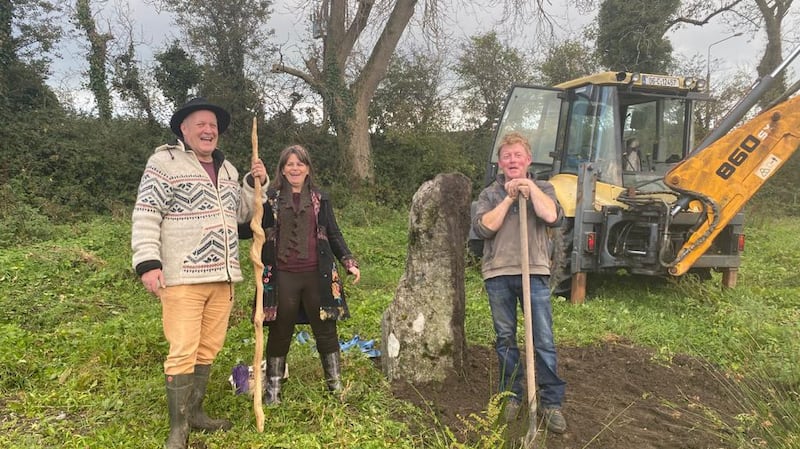I am in rural Kerry, in the fog, looking for the last house on a green-spined track that ends at a mountain. My directions include opening and closing gates to keep horses in. For quite a time, I am accompanied by a lone sheep, who keeps looking back through the fog, and waiting for me to catch up. I am nearly undone at one point by a gradient of roughly 70 degrees, and find my car slipping backwards down the track, uncomfortably close to the boggy edge, while the sheep stands calmly, watching, and waiting.
The last house on this track is where two druids live, so there seems something apt about such a remote location. I have never knowingly met a druid before, and perhaps many of them live in apartments in cities, or suburban housing estates, but it seems like druids should live in beautiful places: in forests, or near mountains, or among nature at its most unspoiled.
Several cart horses roam in the wilderness between two sets of locked gates. When the sheep leaves me, horses start following my car instead, like extremely large and curious dogs. Dutch-born Jan Tetteroo is waiting by the gate to the house where he lives with his wife, Karen. Arrival, as he closes another gate behind me, definitely feels like an event.
“You must have the scenic seat,” Jan says, when we’re all inside, indicating the far end of the table. He’s joking. Every view from every window is otherworldly. It’s just bog, mountains, and huge skies.
Later, Karen says that this townland once had a population of 100, and even a school. It is just the two of them here now, amid a landscape of many ruined buildings.
For me, a druid is someone who feels a deep connection with Mother Earth and with the land, and what's on the land: stones, animals, mountains. It's a way of life
The Tetteroos made news earlier this winter when they were asked by a West Cork farmer, Donal Bohane, to participate in a stone-raising ceremony. In 2009, a bull had toppled a Bronze Age standing stone on family land near Skibbereen. Bohane wanted to reinstate it.
“He wanted to restore the stone, and also restore his fortunes, because he had had a run of bad luck since,” Jan explains. “His fields had flooded, he missed the harvest, he had disease in his cattle.”
So what is a druid? What qualities do they have that a farmer with a fallen ancient stone calls upon them to help restore his fortunes?
“A druid in the modern days is a person who has developed some knowledge,”Jan says. “Who has learned for years. Who has got knowledge about nature, spirituality, the other world, history, philosophy, the arts; and who makes that a central part of his life. All the decisions he makes in his life more or less derive from that.”
“For me, a druid is someone who feels a deep connection with Mother Earth and with the land, and what’s on the land: stones, animals, mountains. It’s a way of life. It’s to feel connected to nature,” Karen says.
Own vocabulary
The couple, who are both Dutch, met within the druid community in the Netherlands 13 years ago. It’s a community with its own vocabulary. A “grove” is a local group, which is facilitated by a druid who has completed certain studies. Not everyone in the grove is a druid; it includes people who are simply curious and interested in learning more. In the Netherlands. Jan was one of the founders of a grove there, which had 400 members, including Karen, which is how they met.
Once you’ve joined a grove, and wish to become a druid, there is a process to follow. “You start your study at the Order of Bards, Ovates and Druids,” Jan explains. “The order connects over 20,000 individuals, either studying, or who have completed, the study of druidery.”
These 20,000 people are located all over the world. “Our worldwide gatherings are in Glastonbury, also known as Avalon. The order is located in the UK, so most are in the UK. I know of big groups in Germany, France, the Netherlands, Italy. There are smaller groups in Australia and the United States.” The Tetteroos know at least six other practising druids living in Kerry alone.

Jan explains that each of the three elements of the order focuses on a different area of study. “The bard is based on study of the arts and performing arts; the ovates on the spiritual world, and the druid on studies in philosophy, myth and legend.”
What is an “ovate”?
“Like a Celtic shaman.”
They say that there is no dogma in druidery, and although they are environmentally aware, there is, for instance, no requirement to be a vegetarian.
Do they believe in an afterlife?
“We think of the spirit as something that was there when we came and will still be there when the vessel we are living in now is gone,” Jan says. “We believe in the eternity of spirit.”
Some people wish to have special druid names, which they don’t exactly choose, but arrive at them via a mystical process. It appears Jan and Karen have druid names, but they don’t wish to reveal them.
“Some of the learning on the path of a druid is like is a mystery school,” Karen says. “You have to find your own druid name.”
“There is some esoteric, hidden knowledge, that you are asked not to share,” Jan says. “Some people have two Facebook accounts, a personal account and a druid account with their druid name. Because they don’t want to come out as druids.”
Before we do it, we tune in and see if it is okay to do the ceremony. I need to feel if there are good energies. And I ask the spirits if we are welcome
The couple married five years ago, wearing their long robes, which they show me. Four years ago, they moved to this remote part of Kerry. Why did they decide to move to Ireland?
“When we met, we had a feeling that we had to go to Ireland,” Karen says. “Our first holiday was to Ireland. Our second holiday was to Ireland. Our third holiday... we thought, hmm, we could live here. But how? So then we started searching for a place where we could live and work. We found this place on the internet. It had been empty for 10 years.”
Web designer
Since moving here, Jan works remotely as a web designer, and they also run a small B&B. Prior to the pandemic, they had started up their own Irish grove, the Grove of Anu. Gatherings and ceremonies, such as for the recent solstice, like so many things this year, had to move online instead.
There is a large television screen in the room where we are. I’m curious: what do druids watch on TV?
“We don’t have satellite, so we watch Netflix,” Jan says. “We watched the chess thing [The Queen’s Gambit]. We give all the fantasy series a chance. Sometimes it lasts only for one or to episodes.”
When Donal Bohane wanted to put his standing stone up again, in an effort to restore his fortunes, a contact in University College Cork put him in touch with the Tetteroos. They agreed to perform a ceremony at the site, while a piece of machinery raised the stone to its original upright place.
It should be noted that anyone wishing to carry out work on a standing stone, stone row, rath, fairy fort or stone circle on private property is obliged to first check if it is a protected structure under the National Monuments Act. Two month’s written notice must be given in advance of any such work to the Minister for Heritage.
So what does a druidic ceremony involve? Is there chanting, or talking? What happened that day in the field near Skibbereen?
“Before we do it, we tune in and see if it is okay to do the ceremony,” Karen says. “I feel. I need to feel if there are good energies. And I ask the spirits if we are welcome; if it is okay that we do our work there. And I heard that day it was okay. It was beautiful. I sensed an awareness. I don’t see it, but I sensed it. The awareness was that we were welcome in the field to do this ceremony, and when I am in the field, I feel what I call earth energies.”
After performing a ceremony, they ask the person to plant native trees on a plot on their land, should they have land. “To do something good for the environment.”
Both Jan and Karen point out it is not enough for them to perform a ceremony; the person or people for whom they are doing it must to be open to it.
“We always say to everybody we help, we can do only so much,” Jan says. “Your mindset has to also do some work. We can’t communicate with the other dimensions for you if you don’t believe. You have to do the work yourself as well. If you don’t act accordingly, you will still have bad luck. If someone doesn’t want to change, that is up to them. It is not just about calling in a druid, and now everything is fine about the bad luck you were having.”
In January, the Tetteroos will be starting their own online “druidist” course, for those interested in learning more. “It will be an online college grove,” Jan says. “If you complete it, by the end you will be druidist.”
This article was updated on Monday, January 4th, to clarify rules regarding protected structures under the National Monuments Act




















